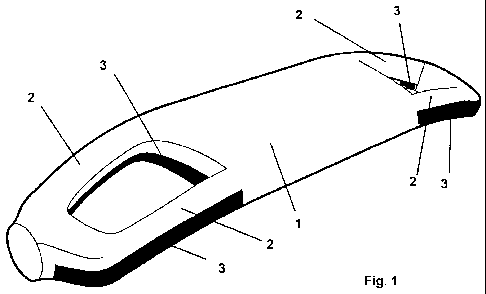Some of the information on this Web page has been provided by external sources. The Government of Canada is not responsible for the accuracy, reliability or currency of the information supplied by external sources. Users wishing to rely upon this information should consult directly with the source of the information. Content provided by external sources is not subject to official languages, privacy and accessibility requirements.
Any discrepancies in the text and image of the Claims and Abstract are due to differing posting times. Text of the Claims and Abstract are posted:
| (12) Patent: | (11) CA 2734603 |
|---|---|
| (54) English Title: | HANDLE FOR A TRANSPORT CART |
| (54) French Title: | POIGNEE POUR UN VEHICULE DE TRANSPORT |
| Status: | Granted and Issued |
| (51) International Patent Classification (IPC): |
|
|---|---|
| (72) Inventors : |
|
| (73) Owners : |
|
| (71) Applicants : |
|
| (74) Agent: | SMART & BIGGAR LP |
| (74) Associate agent: | |
| (45) Issued: | 2014-06-03 |
| (86) PCT Filing Date: | 2008-08-21 |
| (87) Open to Public Inspection: | 2010-02-25 |
| Examination requested: | 2011-03-03 |
| Availability of licence: | N/A |
| Dedicated to the Public: | N/A |
| (25) Language of filing: | English |
| Patent Cooperation Treaty (PCT): | Yes |
|---|---|
| (86) PCT Filing Number: | PCT/DE2008/001373 |
| (87) International Publication Number: | WO 2010020200 |
| (85) National Entry: | 2011-02-17 |
| (30) Application Priority Data: | None |
|---|
The invention relates to a handle for a transport cart, which has conductive
regions, wherein said conductive
regi-ons of the handle are located precisely in the regions that provide the
user with the most beneficial leverage when maneuvering the
transport cart. Said regions are located in the lateral regions of the handle,
where the conductive regions of the handle are also
lo-cated, wherein the conductive regions in turn are connected to the
remaining material of the transport cart in a conductive manner.
Linvention concerne une poignée pour un véhicule de transport comprenant des parties conductrices qui se trouvent précisément dans les zones offrant à lutilisateur les forces de levier les plus favorables, lors des manuvres du véhicule de transport. Ces zones se trouvent dans les parties latérales de la poignée, où se trouvent également les parties conductrices de la poignée, les parties conductrices étant de leur côté en liaison conductrice avec le reste de matériau du véhicule de transport.
Note: Claims are shown in the official language in which they were submitted.
Note: Descriptions are shown in the official language in which they were submitted.

2024-08-01:As part of the Next Generation Patents (NGP) transition, the Canadian Patents Database (CPD) now contains a more detailed Event History, which replicates the Event Log of our new back-office solution.
Please note that "Inactive:" events refers to events no longer in use in our new back-office solution.
For a clearer understanding of the status of the application/patent presented on this page, the site Disclaimer , as well as the definitions for Patent , Event History , Maintenance Fee and Payment History should be consulted.
| Description | Date |
|---|---|
| Maintenance Request Received | 2024-08-07 |
| Maintenance Fee Payment Determined Compliant | 2024-08-07 |
| Inactive: COVID 19 - Deadline extended | 2020-08-06 |
| Common Representative Appointed | 2019-10-30 |
| Common Representative Appointed | 2019-10-30 |
| Change of Address or Method of Correspondence Request Received | 2018-01-12 |
| Small Entity Declaration Determined Compliant | 2018-01-04 |
| Inactive: Correspondence - Prosecution | 2018-01-04 |
| Small Entity Declaration Determined Compliant | 2017-09-25 |
| Small Entity Declaration Request Received | 2017-09-25 |
| Small Entity Declaration Request Received | 2017-09-25 |
| Letter Sent | 2017-08-29 |
| Letter Sent | 2017-08-29 |
| Inactive: Multiple transfers | 2017-08-09 |
| Grant by Issuance | 2014-06-03 |
| Inactive: Cover page published | 2014-06-02 |
| Pre-grant | 2014-03-17 |
| Inactive: Final fee received | 2014-03-17 |
| Notice of Allowance is Issued | 2014-02-06 |
| Notice of Allowance is Issued | 2014-02-06 |
| Letter Sent | 2014-02-06 |
| Inactive: Q2 passed | 2014-01-27 |
| Inactive: Approved for allowance (AFA) | 2014-01-27 |
| Amendment Received - Voluntary Amendment | 2013-12-18 |
| Inactive: S.30(2) Rules - Examiner requisition | 2013-06-27 |
| Amendment Received - Voluntary Amendment | 2013-04-29 |
| Inactive: S.30(2) Rules - Examiner requisition | 2012-10-29 |
| Letter Sent | 2011-10-04 |
| Inactive: Cover page published | 2011-04-19 |
| Inactive: Inventor deleted | 2011-04-13 |
| Inactive: Notice - National entry - No RFE | 2011-04-13 |
| Application Received - PCT | 2011-04-04 |
| Inactive: IPC assigned | 2011-04-04 |
| Inactive: First IPC assigned | 2011-04-04 |
| Request for Examination Received | 2011-03-03 |
| Request for Examination Requirements Determined Compliant | 2011-03-03 |
| All Requirements for Examination Determined Compliant | 2011-03-03 |
| National Entry Requirements Determined Compliant | 2011-02-17 |
| Application Published (Open to Public Inspection) | 2010-02-25 |
There is no abandonment history.
The last payment was received on 2013-07-23
Note : If the full payment has not been received on or before the date indicated, a further fee may be required which may be one of the following
Please refer to the CIPO Patent Fees web page to see all current fee amounts.
Note: Records showing the ownership history in alphabetical order.
| Current Owners on Record |
|---|
| FRANZ WIETH |
| ANDREAS FILOSI |
| Past Owners on Record |
|---|
| HORST SONNENDORFER |